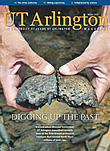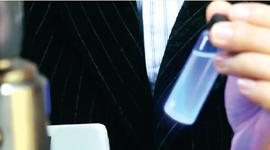What lies beneath
UT Arlington is leading a rare urban dinosaur dig that could unearth new species and unlock clues to the giant creatures that ruled North Texas 95 million years ago.
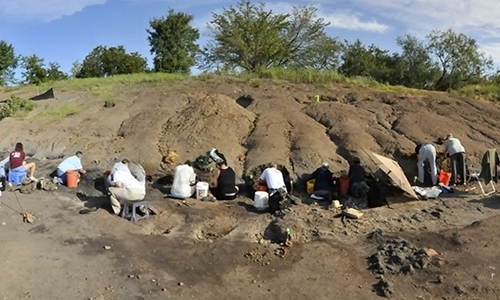
They kneel at a rise on the prairie near Arlington’s northern edge on a Saturday morning, half a dozen volunteers, some with umbrellas raised against a fierce, late-summer sun. One picks gently at the black earth with a dental tool, carefully uncovering something smooth and reddish brown. The work is painstaking, the reward immense: The fossil at the Arlington Archosaur Site is a 95 million-yearold crocodile snout, possibly belonging to a new species.
The big crocodile has equally important company. The site so far has yielded bones that belonged to a possible new species of carnivorous dinosaur, a new lungfish and what may be either Protohadros—a missing link in the dinosaur world—or another new species. The name archosaur covers both dinosaurs and crocodiles, the ruling reptiles of the time.
By all accounts, in Texas and nationally, UT Arlington doctoral candidate Derek Main has an exciting dissertation on his hands. Few major dinosaur excavations lie 10 minutes from a freeway. Few yield fossils from the Mid-Cretaceous Period, a kind of paleontological twilight zone. Beyond that, Main says, “the big picture is that it’s not just another dinosaur site; it’s a Cretaceous coastal ecosystem,” a snapshot of an ancient environment and its creatures.
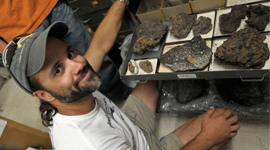
Doctoral candidate Derek Main leads the excavation efforts at the Arlington Archosaur Site, which he calls a “Cretaceous coastal ecosystem.” Since its discovery in 2003, the site has yielded bones that belonged to a possible new species of carnivorous dinosaur, a new lungfish and what may be either Protohadros—a missing link in the dinosaur world—or another new species.
That makes it both rare and important, notes Main’s professor, Christopher Scotese of the Earth and Environmental Sciences Department. “The site is significant because it has a diverse fauna of reptiles and also abundant plant material, and the rock and the geology tell us quickly what kind of environment they lived in.”
Main’s Land Rover bounces up the dirt track and he jumps out. Diggers caked with mud smile at him, speaking dig shorthand: “croc teeth,” “dino site,” “paleo.” Main, bearded and wiry, seldom stops for long. He admires an emerging turtle fossil, gives guidance at the dinosaur excavation, gets an update from the dig crew chief, rounds up volunteers to work on further screening elsewhere and is gone for the moment.
This 2,200-acre swath of grassy, treed prairie was part of a flat shelf in an ancient ocean between 119 million and 95 million years ago, explains Southern Methodist University’s Louis Jacobs in his book Lone Star Dinosaurs. As Main puts it, “Arlington was the Galveston or the Mississippi Delta of the Cretaceous.” More than half of Texas was under water.
Herbivorous dinosaurs may have splashed along in the mud at the Arlington site, avoiding crocodiles 15-20 feet long. Meateating therapods, another kind of dinosaur, also hunted here. Sharks, lungfish and turtles swam in the water.
Trees, probably mangroves, grew—and fell—along the edges of the swampy land. The positions of the log fossils at the site, some exceeding 9 feet, may tell researchers how the water currents flowed. Crumbling chunks of fossilized wood turned black and glossy indicate a forest fire must have raged.
A big claim to fame for the Arlington dinosaurs and crocodiles is their place in ancient history. The Mid-Cretaceous Period was before the big pop culture creatures like T. rex and Triceratops, which lived near the end of the Cretaceous. That puts the local dinos in a position to tell the world moreabout a time that’s been short on clues.
“The Mid-Cretaceous is not particularly well known,” says David Weishampel, a prominent researcher at the Center for Functional Anatomy and Evolution at the Johns Hopkins University School of Medicine. “[Main is] adding more and more to the information we have. It’s not known particularly well in this country and not particularly well internationally, either.”
Fast-forward 95 million years. That’s when Art Sahlstein, Phil Kirchhoff and Bill Walker came on the scene. The question of who was there first has become, well, academic. The three have agreed to share the discovery of the site.
Sahlstein, who lives in Euless, says it was Jan. 17, 2003, when he took his daughter along for his daily prayer walk on the open land near his home. As he walked, Sahlstein looked up a lot of the time. But 7-year-old Olivia, less given to chatting with the deity, was looking down.
“She reached down and pulled a vertebra directly out of the ground,” Sahlstein recalls. “She said, ‘This is a dinosaur bone.’ ” It was. Sahlstein continued to collect material and tried to get someone interested, but to no avail.
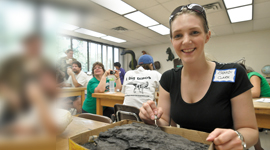
Junior geology major Brandi Clark helps prepare the fossils for study and publication. Cleaning one piece of crocodile bone can take hours, she says.
Depending on whom you ask, Kirchhoff and Walker were fossil hunting on the same land at about the same time, or maybe it was a few months later. In any case, Kirchhoff says he was crawling on the ground and “finding these big, giant teeth, big as your thumb, and a vertebra.”
A fossil fanatic who went back to school for an anthropology degree, Kirchhoff was in a class taught by Dr. Scotese and took the goods to him. Scotese got Main involved. Though he was then working with Scotese on a dinosaur biogeography project, Main suddenly had an astonishing new doctoral dissertation topic.
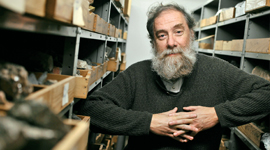
Earth and environmental sciences Professor Christopher Scotese, Main’s supervising professor, commends Huffines Communities, which owns the land, for making the property accessible and supporting the discoveries.
Today the question of who found the site seems moot. Sahlstein’s house serves as headquarters for some of the off-site work, and he’s at the dig almost every weekend. Kirchhoff is busy working on his degree and finding new fossils elsewhere.
“To me, it’s not who found it,” Main says, “but what we have found and the fact that we are now all working together as a team.”
There’s no disputing who owns the recent crocodile discovery. Richland High School student Austin Motheral, 15, will some day have a giant, prehistoric reptile named after him if this proves to be a new species. Austin was watching his dad scoop out that section of the site with a tractor when “a vertebra popped up.” He made his dad stop the tractor, and he and his uncle started digging.
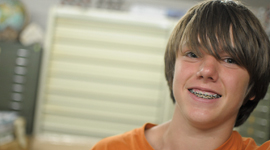
High school student Austin Motheral is credited with discovering the bones of a 95 million-year-old crocodile.
Now the teenager is a regular at the site, hiking around, spotting fossils and helping out. He was there on another scorching late-summer day when some 20 people were working the crocodile site, nicknamed Crocorama, as well as the dinosaur excavation. The huge find, the one everyone was hoping for, would be a dinosaur skull.
The big animal whose bones are being filed away on campus may be Protohadros, a duckbilled dinosaur that was a missing evolutionary link between two species in the shadowy Mid-Cretaceous.
Protohadros was discovered and named when a skull was found in the 1990s near Flower Mound. The Arlington site is adding almost everything but a skull. And Main says it will be difficult to prove exactly what he has without one. But he’s not stopping to agonize over it. Crocorama is yielding finds at almost every dig.
Volunteers also have found a good deal of fossilized dung, called coprolite, which is a lot more important than it sounds. While paleontologists usually cradle fragile fossils from the ground to the lab and beyond, trying to keep them all in one piece, coprolite is an exception. Main says researchers slice into these pieces to learn “who was eating who.”
That type of work is being done on campus. One student, Brandi Clark, has spent hours cleaning up a piece of crocodile bone. It’s a tedious job. “If I finish this by the end of the semester, I’ll be happy,” the geology undergraduate says.
The clean-up, then comparative study and eventually publication must be done before any of the dig’s finds are recognized. “There are no new species until the study is done and it’s proved,” Dr. Jacobs says. “Comparisons have to be made and it has to be published.” That requires careful collection.
A volunteer approaches dig crew chief Roger Fry’s table, treasures in hand. Fry examines one. “That’s what we call leaverite,” he says. “Stands for leave her right where you found her.” He eyes another.
“Rock,” he says, tossing it aside.
In real life an operations manager at a staffing company, Fry has a serious paleo bent that led Main to name him crew chief and lead preparator. He has marked off the site in a grid, which matches the grid in his field book. Every tooth and scute (the plates on a crocodile’s shell) must pass his muster.
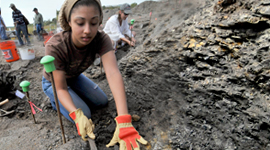
Weekend digs at the Arlington Archosaur Site in north Arlington attract dozens of volunteers like sophomore Sharifa Chess.
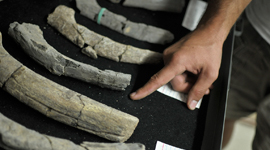
Fossils are meticulously logged and brought to campus for storage and examination. A permanent home for the findings, which is key to their preservation, has yet to be determined.
The dig is also making its way into other classrooms across the Metroplex. Many of the diggers in the all-volunteer effort (except for Main’s students, whom he volunteers) are schoolteachers, hoping to share bits of rock and experience with their students.
“Amateurs can’t get opportunities like this,” says Doug Penny, a fourth-grade teacher at Johns Elementary School in Arlington.
Most of the teachers and their charges are living atop still more dinosaurs. The Arlington site is part of the Woodbine Formation, fossil-laden rock that extends under Dallas/Fort Worth International Airport and toward East Texas. “People forget what they live on,” Main says.
Fortunately, Huffines Communities, which owns the property where the site was found, is interested in knowing what’s beneath the land before construction begins in earnest on Viridian, a retail-residential
development.
“They’ve made everything much more accessible and easy to get to and are very good proponents of the work,” says Scotese, who adds that the development plans actually helped. “It’s in an area that had been sort of predevelopment; a lot of the surface rock had been scraped away. So we’re getting a good look at the underlying bedrock.”
Main and his team have been scrambling to find as much as possible before May 2010, the deadline given in the agreement that grants UT Arlington permission to dig. Co-owner Phillip Huffines says the company is willing to discuss extending the completion date if the extraction takes longer.
“We hope this discovery helps document and further expand the understanding of the historical data for the property, North Texas and the region,” he says.
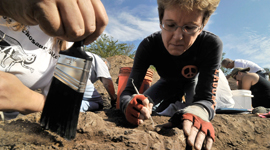
Volunteer Darlene Sumerfelt participates in a weekend dig.
After the dig is finished, study is far from the last step. Jacobs says a proper resting place for the material also is important for research reasons. “It has to be in a repository that makes it accessible and permanent. They have to have one if it’s going to have any scientific validity. It needs to be in a museum somewhere, either a university or a public museum.”
Today the large dinosaur bones are in a metal cabinet in the same storeroom with the crocodile bones, the foundation for what may one day be the Scotese Museum of Paleontology. Now, Scotese says, “the collections are small enough that we can house them in the department.”
While a final repository hasn’t been decided, everyone agrees that the site is important for UT Arlington as an educational tool. Main’s face lights up when asked about it.
“To go on a dinosaur dig, it’s something people only dream about,” he says. “I think this stands out as a much more powerful teaching tool” than sitting in a classroom.
College of Science Dean Pamela Jansma, who joined UT Arlington in August, says that besides local school district involvement, the work also is good for college students interested in paleontology.
“They don’t usually have things like this in their backyard. If you read about dinosaur discoveries or important paleontological breakthroughs, most of the time they’re in China, Mongolia, Africa. They’re far away. It is a rare opportunity, especially in such a metropolitan area.”
Finding a permanent home for the fossils is also key for preservation, Main says. The crocodile fossils contain pyrite.
“Pyrite disease can and will destroy them. It’ll turn the bones into powder. They need to be stored in a humidity-free environment.”
Until then, he and Fry and the determined amateur diggers are focused on getting what they can for as long as they can.
“There’s so much we have yet to learn about this period,” Main says. “The Arlington Archosaur Site project has certainly captured the public’s attention and imagination. Why not continue and build on that success?”
Dig in, everybody. The all-volunteer excavation seeks donations and diggers.
Visit www.arlingtonarchosaursite.com to learn more.
- Facebook members can join the Arlington Archosaur Site group for dig dates and information.
- Archosaur T-shirts are for sale on the Web site, with proceeds benefiting the project.
- Tax-deductible donations, which pay for equipment and supplies, may be made at https://www.uta.edu/giving/sub/givenowarchosaur.php.



